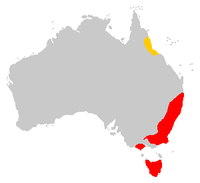Spotted Quoll
|
|
| Spotted Quoll Conservation status: Vulnerable | ||||||||||||||||
|---|---|---|---|---|---|---|---|---|---|---|---|---|---|---|---|---|
| Missing image SpottedQuoll_2005_SeanMcClean.jpg Spotted Quoll | ||||||||||||||||
| Scientific classification | ||||||||||||||||
| ||||||||||||||||
| Binomial name | ||||||||||||||||
| Dasyurus maculatus Kerr, 1792 |
The Spotted Quoll, also known as the Spotted-tail Quoll and the Tiger Quoll, is a carnivorous marsupial mammal, native to Australia. It is mainland Australia's largest carnivorous marsupial.
Taxonomy
There are two subspecies of the Spotted Quoll,
- the southern subspecies, Dasyurus maculatus maculatus (Kerr 1792), and
- the northern subspecies Dasyurus maculatus gracilis (Ramsay 1888).
The Spotted Quoll belongs to the Dasyuridae family, which also includes other species of quolls, the extinct Thylacine, the Tasmanian Devil and many smaller carnivores. There are three other species of quoll in Australia; two more live in Papua New Guinea.
Life history
The Spotted Quoll ranges from 35 to 75 cm in length and has a tail of about 34 to 50 cm. Females are smaller than than the males: while females grow to four kilograms, males can reach up to 7 kg. Quolls have thick, soft fawn, brown or black fur. Small white spots cover the body except for the bushy tail, which may have a white tip.
Quolls feed on a large range of prey including birds, rats and other marsupials, small reptiles and insects. They are good climbers but spend most of their time on the forest floor. Although nocturnal, they spend the daylight hours basking in the sun. They nest in rocky banks, hollow logs or small caves.
They produce one litter a year with four to six young. The gestation period is 21 days. The young remain in their mother's pouch for about seven weeks, and it takes some 18 weeks for them to become independent of the mother. Sexual maturity is reached after one year. Spotted Quolls can get 4 to 5 years old.
Range and Habitat
Before European settlement the southern subspecies had a range extending from southern Queensland through coastal New South Wales and Victoria to Tasmania. It is now confined to a few areas, mostly in national parks, and listed as threatened in all mainland states. Land clearing, habitat destruction, foxes and feral and domestic cats have led to the decline.
The northern subspecies of the Spotted Quoll lives in restricted areas around Cairns and Cooktown in northern Queensland, and also in Papua New Guinea. It is slightly smaller than the southern subspecies.
Conservation Status
The Spotted Quoll is listed by the IUCN on the Red List of Threatened Species with the status "vulnerable". The Australian Department of the Environment and Heritage considers the northern subspecies D.m. gracilis as endangered.
External links
- Description (http://animaldiversity.ummz.umich.edu/site/accounts/information/Dasyurus_maculatus.html) from the University of Michigan
- Another description (http://www.acay.com.au/~turtonm/quoll.htm) from Australia.
- Australian Web Site (http://www.oren.org.au/issues/endspp/Tigerquoll/tigerquoll.htm)
- Australian Quoll Seekers (http://www.quollseekers.com/)
- Spotted Quoll entry (http://www.redlist.org/search/details.php?species=6300) in the IUCN Red List.
- Action Plan (http://www.deh.gov.au/biodiversity/threatened/action/marsupials/index.html) for Australian Marsupials and Monotremes.

